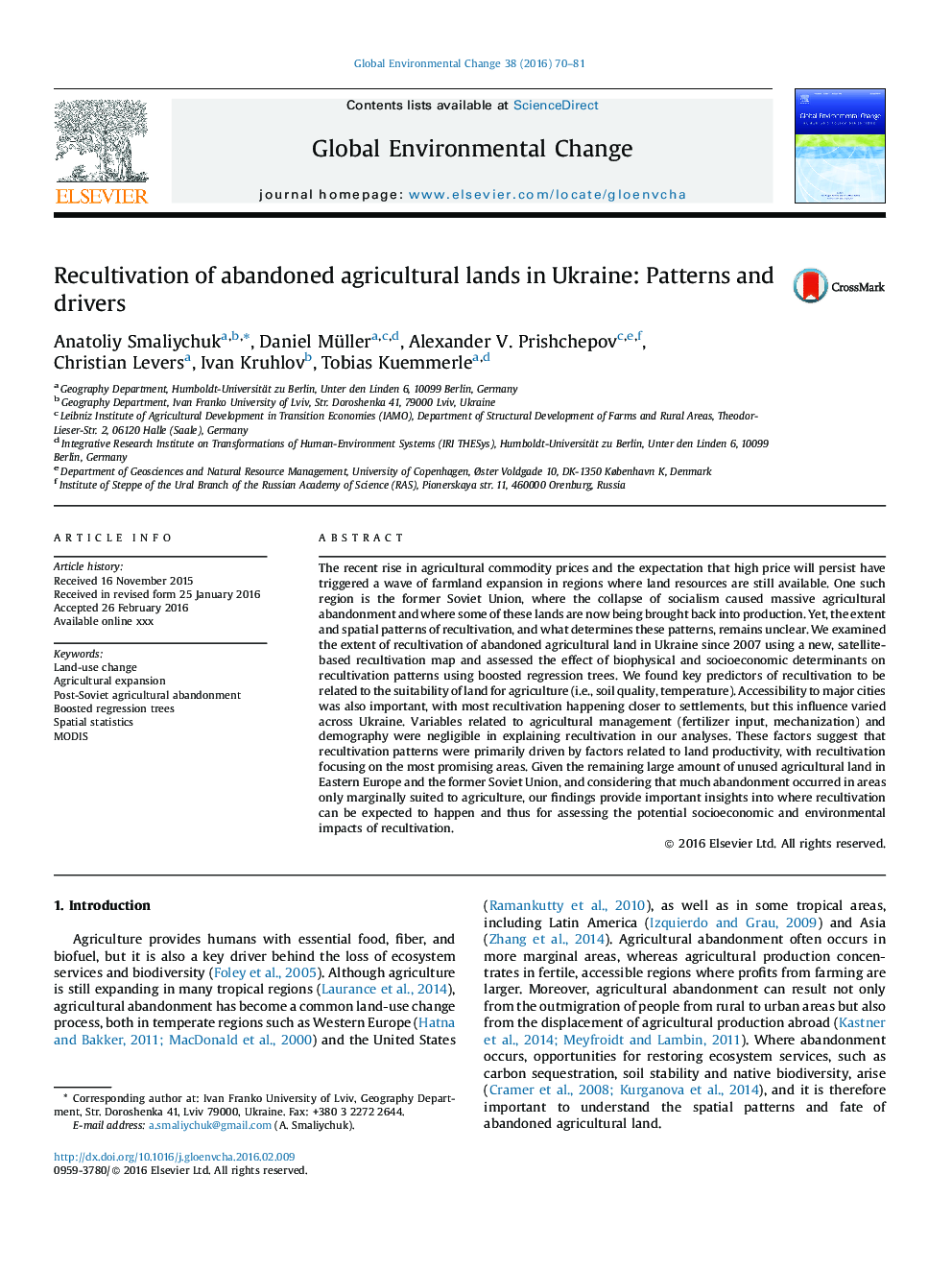| کد مقاله | کد نشریه | سال انتشار | مقاله انگلیسی | نسخه تمام متن |
|---|---|---|---|---|
| 7469341 | 1485120 | 2016 | 12 صفحه PDF | دانلود رایگان |
عنوان انگلیسی مقاله ISI
Recultivation of abandoned agricultural lands in Ukraine: Patterns and drivers
ترجمه فارسی عنوان
تجدید زمین های رها شده در اوکراین: الگوها و رانندگان
دانلود مقاله + سفارش ترجمه
دانلود مقاله ISI انگلیسی
رایگان برای ایرانیان
کلمات کلیدی
ترجمه چکیده
افزایش اخیر قیمت های کالاهای کشاورزی و انتظار بر این است که قیمت بالا همچنان ادامه داشته باشد، موجی از گسترش زمین های کشاورزی را در مناطقی که منابع زمین هنوز در دسترس هستند، موجب شده است. یکی از این مناطق اتحاد جماهیر شوروی سابق است، جایی که فروپاشی سوسیالیسم باعث انزوای گسترده کشاورزی شد و در حال حاضر برخی از این اراضی به تولید بازگشته است. با این حال، میزان و الگوهای فضایی بازسازی و آنچه که این الگوها را تعیین می کند، هنوز نامشخص است. ما از سال 2007 با استفاده از یک نقشه بازسازی جدید مبتنی بر ماهواره و بررسی تاثیر تأثیر عوامل بیوفیزیکی و اقتصادی اجتماعی بر الگوهای بازخوانی با استفاده از درختهای رگرسیونی به دست آمده بررسی شد. ما پیش بینی های کلیدی بازتولید را در رابطه با مناسب بودن زمین برای کشاورزی (یعنی کیفیت خاک، درجه حرارت) پیدا کردیم. دسترسی به شهرهای بزرگ نیز مهم بود، زیرا اکثر مراحل بازتولید شدن به شهری نزدیک می شد، اما این تاثیر در سراسر اوکراین متفاوت بود. متغیرهای مربوط به مدیریت کشاورزی (ورودی کود، مکانیزاسیون) و جمعیت شناسی در توضیح بازآموزی در تحلیل های ما ناچیز بود. این عوامل نشان می دهد که الگوهای بازسازی در درجه اول به عوامل مربوط به بهره وری از زمین، با بازآفرینی متمرکز بر مناطق بیشتر امیدوار کننده است. با توجه به مقدار زیادی از زمین های کشاورزی استفاده نشده در اروپای شرقی و اتحاد جماهیر شوروی سابق و با توجه به این که بسیاری از واگذاری ها در مناطقی است که فقط به کشاورزی منحصر بفرد مربوط می شوند، یافته های ما، بینش های مهم را در مورد جایی که بازسازی ممکن است انتظار می رود اتفاق می افتد و در نتیجه برای ارزیابی تاثیرات اجتماعی و اقتصادی محیطی و بازتوزیع زیست محیطی.
موضوعات مرتبط
علوم زیستی و بیوفناوری
علوم محیط زیست
علوم زیست محیطی (عمومی)
چکیده انگلیسی
The recent rise in agricultural commodity prices and the expectation that high price will persist have triggered a wave of farmland expansion in regions where land resources are still available. One such region is the former Soviet Union, where the collapse of socialism caused massive agricultural abandonment and where some of these lands are now being brought back into production. Yet, the extent and spatial patterns of recultivation, and what determines these patterns, remains unclear. We examined the extent of recultivation of abandoned agricultural land in Ukraine since 2007 using a new, satellite-based recultivation map and assessed the effect of biophysical and socioeconomic determinants on recultivation patterns using boosted regression trees. We found key predictors of recultivation to be related to the suitability of land for agriculture (i.e., soil quality, temperature). Accessibility to major cities was also important, with most recultivation happening closer to settlements, but this influence varied across Ukraine. Variables related to agricultural management (fertilizer input, mechanization) and demography were negligible in explaining recultivation in our analyses. These factors suggest that recultivation patterns were primarily driven by factors related to land productivity, with recultivation focusing on the most promising areas. Given the remaining large amount of unused agricultural land in Eastern Europe and the former Soviet Union, and considering that much abandonment occurred in areas only marginally suited to agriculture, our findings provide important insights into where recultivation can be expected to happen and thus for assessing the potential socioeconomic and environmental impacts of recultivation.
ناشر
Database: Elsevier - ScienceDirect (ساینس دایرکت)
Journal: Global Environmental Change - Volume 38, May 2016, Pages 70-81
Journal: Global Environmental Change - Volume 38, May 2016, Pages 70-81
نویسندگان
Anatoliy Smaliychuk, Daniel Müller, Alexander V. Prishchepov, Christian Levers, Ivan Kruhlov, Tobias Kuemmerle,
